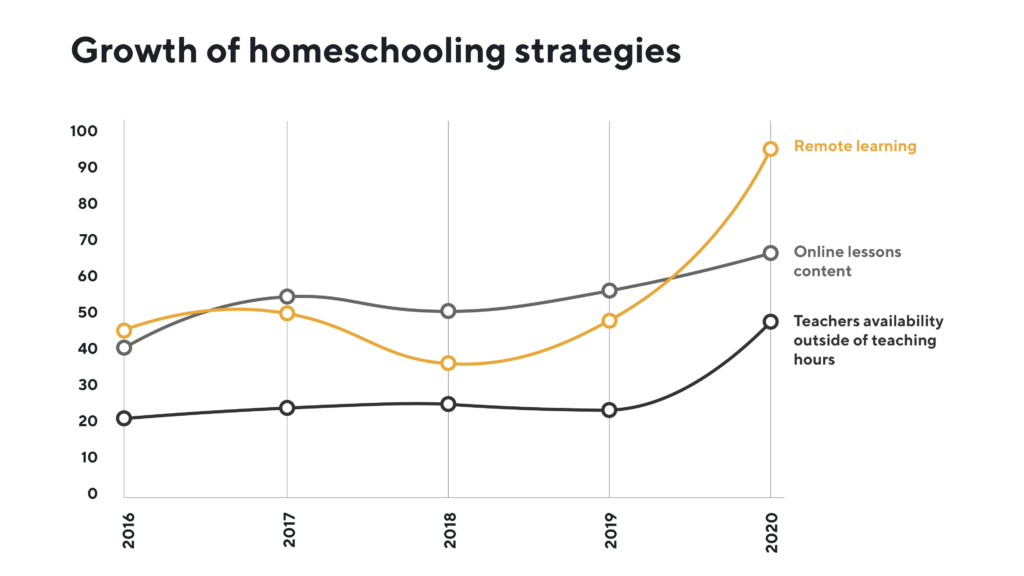In 2020, the global Coronavirus pandemic changed education and the EdTech sectors in ways that no one could have predicted. Around the world, distance learning became the main way students of every age were taught (K-12 and at universities), for many months.
Now in some countries, schools have reopened again as vaccine rollouts intensify, with the aim of life getting back to normal. Does that mean education will get back to normal?
Yes, in many ways. But at the same time, the trends that were already shaping education were accelerated last year, and these trends in EdTech are continuing in 2021. According to an annual UKI State of Technology in Education Report, 9 in 10 educators “believe tech and teaching will seamlessly combine in the future.”

Picture 1. Rising of homeschooling in 2020.
Here are five trends we expect to continue in EdTech throughout 2021, and beyond.
5 EdTech Trends in 2021
#1: Putting education before tech
In the last decade, there have been too many shiny new EdTech tools that are more about the tech than the education side of things. Teachers and students are finding that apps need to be more closely linked with curriculums and educational requirements.
New EdTech investments in schools need to focus on improving educational outcomes, making teachers jobs easier, and enriching learning. Gimmicks and shiny looking apps aren’t as useful as those that make a positive impact in the classroom.
#2: Improve collaboration
EdTech should mirror apps that students use outside of school, in the way that they’re collaborative and social. Students use a wide range of apps, from Instagram to SnapChat and WhatsApp, and YouTube, alongside newer ones such as TikTok. Why shouldn’t EdTech solutions mirror some of the social and collaborative aspects of social apps students use?
Many can, with the right features built-in. Providing there are user safeguards in-place too. Technology that encourages teamwork and collaboration is seen as the way forward in EdTech.

Picture 2. EdTech collaboration.
#3: More data in decision making
K-12 school leaders in particular need to find more creative ways to stretch the budget. That means making smarter, more data-backed purchases, when it comes to EdTech investments.
School leaders need to look closer at what students and teachers need. Assess whether current software and hardware is meeting those needs. And if not, what could be brought on-board to support students and teachers more effectively.
Using data, school leaders can see which apps have high-levels of engagement, and which don’t. These should correlate with the ones that contribute to positive higher learning outcomes. With data and reports from teachers to support this, it should be easier to make more effective decisions when it comes to EdTech investments.
#4: Smarter EdTech investments
Schools at every educational level, from K-12 to postgraduate, are sold on the benefits of EdTech software and hardware. Investments in technology are as normal as buying paper books and pencils 20 years ago; no one needs convincing on the value of tech in education.
However, the pandemic has strained budgets that were already struggling. The education sector around the world is going to have to do more with less. Which means putting an end to the ‘buy, use, dispose’ approach when it comes to EdTech investments.
Hardware in particular is a big investment. Instead of buying tech that gets disposed of every few years, schools are going to need reusable tech, and devices that can be upgraded and repaired, instead of thrown away.

Picture 3. EdTech investments.
#5: Improved accessibility
Lockdowns have exposed some of the failings in EdTech solutions when it comes to students with disabilities. In particular, those with dyslexia, and other disabilities, are at a disadvantage when technology doesn’t support their needs.
Expect to see, as a way of compensating for the failings of some software and hardware, more voice-to-text and text-to-voice tools. These can be easily built-in or overlaid onto other software, and schools can pay on a per user basis, in many cases, thereby improving accessibility for those who need it.
As you can see, last year had a sizable impact on the education sector. EdTech companies have had to adapt as a result. New software and hardware needs to more closely meet the needs of educational leaders, teachers and students to keep succeeding.
LaSoft: Your web and mobile development agency. We are a technology partner you can trust. Get more information today. LaSoft provides a wide range of services, including web and mobile development, product design, management and quality assurance.


